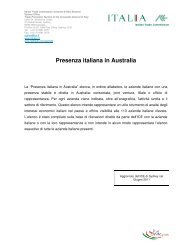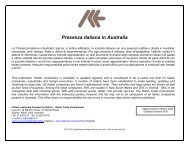Price Determination in the Australian Food Industry A Report
Price Determination in the Australian Food Industry A Report
Price Determination in the Australian Food Industry A Report
You also want an ePaper? Increase the reach of your titles
YUMPU automatically turns print PDFs into web optimized ePapers that Google loves.
Figure 82. Share of retail price of packaged flour<br />
%<br />
100<br />
80<br />
60<br />
retail<br />
wholesale (<strong>in</strong>cludes miller and marketer)<br />
farmgate<br />
40<br />
20<br />
0<br />
Source: <strong>Industry</strong> sources and analysis by Bowman Richards<br />
The past several years have seen a gradual <strong>in</strong>crease <strong>in</strong> <strong>the</strong> share of <strong>the</strong> food sales dollar which has<br />
been captured by <strong>the</strong> retail sector, largely due to <strong>the</strong> competitive nature of <strong>the</strong> bus<strong>in</strong>ess and <strong>the</strong><br />
costs of do<strong>in</strong>g bus<strong>in</strong>ess with major grocery cha<strong>in</strong>s.<br />
The major retailers tender annually for <strong>the</strong> private label products. Contracts tend to be purely<br />
price-based. (Retailers are also prepared to accept product that is out of specification. This puts<br />
pressure on players who produce to specification and thus <strong>in</strong>cur higher costs.)<br />
The marg<strong>in</strong> on private label product for millers has effectively been competed away. Marg<strong>in</strong>s on<br />
branded product vary significantly. This is a major issue for <strong>the</strong> <strong>in</strong>dustry. In some cases it is<br />
claimed that bus<strong>in</strong>ess is be<strong>in</strong>g done at below cost. In branded product <strong>the</strong>re is little relativity<br />
between retail prices and <strong>the</strong> wheat or flour price.<br />
Drivers of cost<br />
The variation <strong>in</strong> costs <strong>in</strong> <strong>the</strong> flour value cha<strong>in</strong> is largely determ<strong>in</strong>ed by <strong>the</strong> annual size of <strong>the</strong> local<br />
and <strong>in</strong>ternational wheat crop. The <strong>Australian</strong> Wheat Board (<strong>the</strong> operator of <strong>the</strong> s<strong>in</strong>gle desk for<br />
export wheat) has a major <strong>in</strong>fluence on wheat prices. In effect, <strong>the</strong> board sets <strong>the</strong> price with pool<br />
announcements and <strong>the</strong> flour miller has to pay more to attract wheat away from <strong>the</strong> pool. Millers<br />
buy most of <strong>the</strong>ir wheat at harvest so price movements after this have little <strong>in</strong>fluence.<br />
<strong>Price</strong> <strong>Determ<strong>in</strong>ation</strong> <strong>in</strong> <strong>the</strong> <strong>Australian</strong> <strong>Food</strong> <strong>Industry</strong> A <strong>Report</strong><br />
The price of flour tends to be set annually – early <strong>in</strong> <strong>the</strong> new year – based on wheat cost. Over <strong>the</strong><br />
year <strong>the</strong> marg<strong>in</strong> gradually erodes away. Thus, if a flour miller does not read <strong>the</strong> market for wheat<br />
prices, <strong>the</strong>n this will impact on <strong>the</strong>ir competitiveness for <strong>the</strong> year. The major cost <strong>in</strong> <strong>the</strong> production<br />
of flour is <strong>the</strong> raw material – wheat and o<strong>the</strong>r <strong>in</strong>gredients account for around 60 per cent of total<br />
costs ex mill (exclud<strong>in</strong>g warehous<strong>in</strong>g and distribution). The graph below shows <strong>the</strong> major cost<br />
components, exclud<strong>in</strong>g market<strong>in</strong>g, promotion and marg<strong>in</strong>s.<br />
Figure 83. Cost components of flour<br />
%<br />
100<br />
80<br />
60<br />
40<br />
20<br />
0<br />
retail marg<strong>in</strong><br />
to distribution centre/store<br />
wholesale marg<strong>in</strong><br />
to packer/market<br />
pack<strong>in</strong>g<br />
grower<br />
Source: <strong>Industry</strong> sources and analysis by Bowman Richards<br />
78







